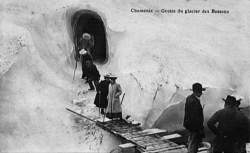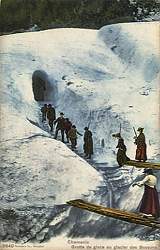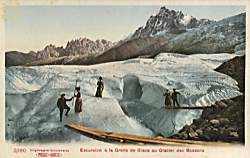Glacier Grotto
Ice Grotto

Ice Grottos or Glacier Grottos are often called ice caves or glacier caves, but both names are wrong. Glacier grottos are artificial caves inside glaciers, Ice caves are caves, typically karst caves or lava tunnels, containing ice. Glacier caves are natural caves in glaciers.

Glacier grottos are made artificial inside glaciers, primarly as a tourist attraction. They have a long history, the first glacier grottoes were made in the second half of the 19th century. The old postcards on this page show one of the first glacier grottos of the world around 1870 on the Glacier des Bossons.
The caves are typically dug out in spring which may take several day or up to one month. And this work has to be repeated every year, as the glacier moves all the time, destroying the cavern slowly. New ice is formed by snow on top of the glacier, moving slowly downhill until it melts at the lower end. Also the seasons of the year have an influence on the glacier.

Most of those grottos contain ice sculptures of changing quality, depending on the ability of the artists. Typically, glacier grottoes are made by individualists.
But many glacier grotto's have no touristic background, are not open to the public. They are made for scientific purposes. Glaciologists dig caves into glaciers all over the world to make various experiments.
Most important are glaciers for climatic research. Every year the winter snow adds a layer of ice to the glacier, so inside the cave the ice shows a sort of pattern, similar to trees. And the ice contains many traces of every years climate. Rare elements, radioactive isotopes and other contents tell the scientists much about our planets climatic history. Glaciers in central Europe allow research for several ten thousand years. Glaciers on the poles tell us even more, but unfortunately it is much harder to get there.
- Examples
 Dachstein Eispalast
Dachstein Eispalast Eisgrotte Stubaier Gletscher
Eisgrotte Stubaier Gletscher Eispavillon Mittelallalin, probably the most interesting of all glacier grottoes, maintained by a glaciologist.
Eispavillon Mittelallalin, probably the most interesting of all glacier grottoes, maintained by a glaciologist. Gletschergrotte Klein Matterhorn, the highest of all glacier grottoes.
Gletschergrotte Klein Matterhorn, the highest of all glacier grottoes. Eisgrotte Rhonegletscher
Eisgrotte Rhonegletscher Gletschergrotte Titlis
Gletschergrotte Titlis Grotte de la Mer de Glace
Grotte de la Mer de Glace Eispalast Jungfraujoch
Eispalast Jungfraujoch
 Search Google for "Glacier Grotto"
Search Google for "Glacier Grotto" How do you stop an ice grotto melting? (visited: 06-APR-2020)
How do you stop an ice grotto melting? (visited: 06-APR-2020)
 Index
Index Topics
Topics Hierarchical
Hierarchical Countries
Countries Maps
Maps Search
Search